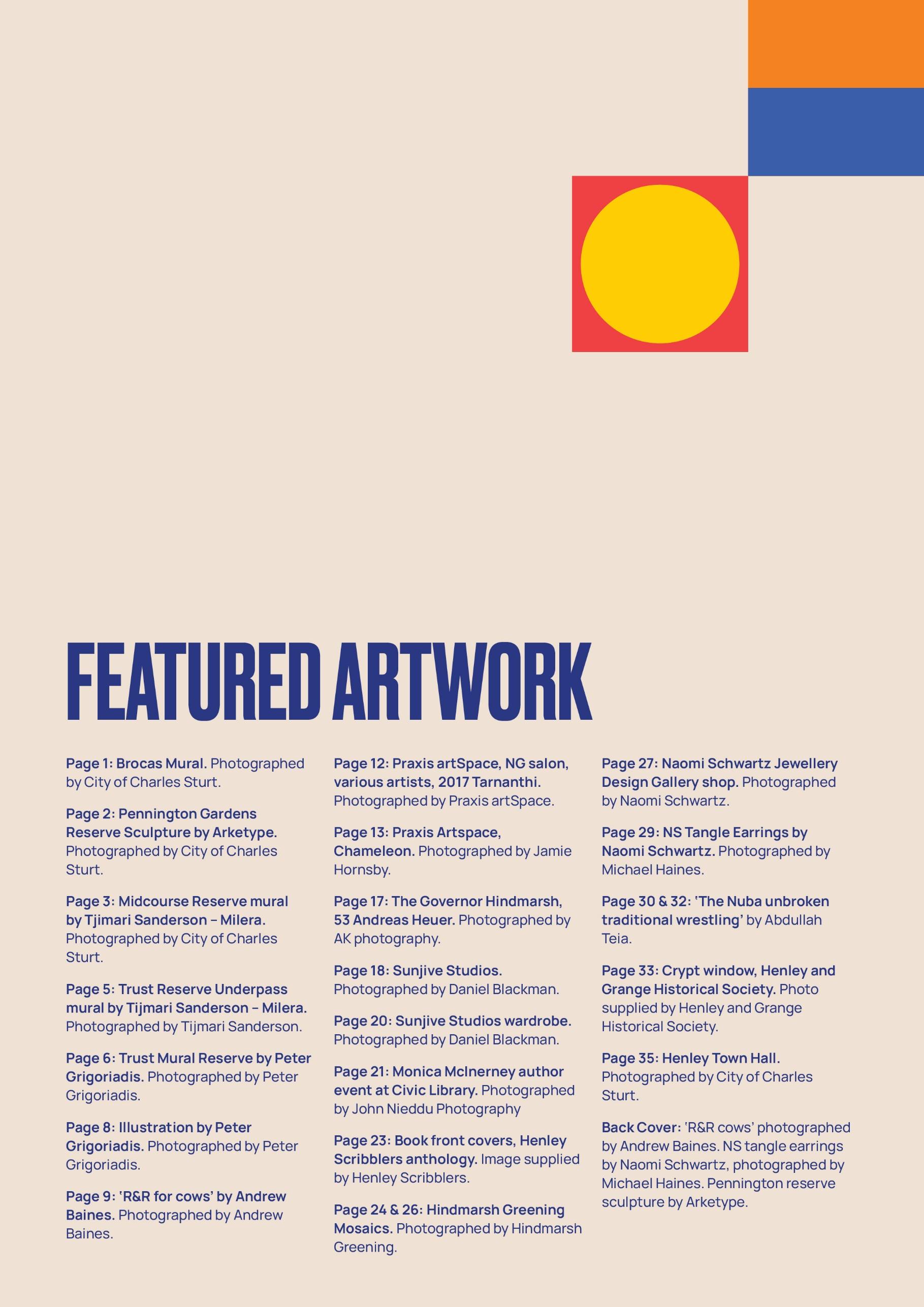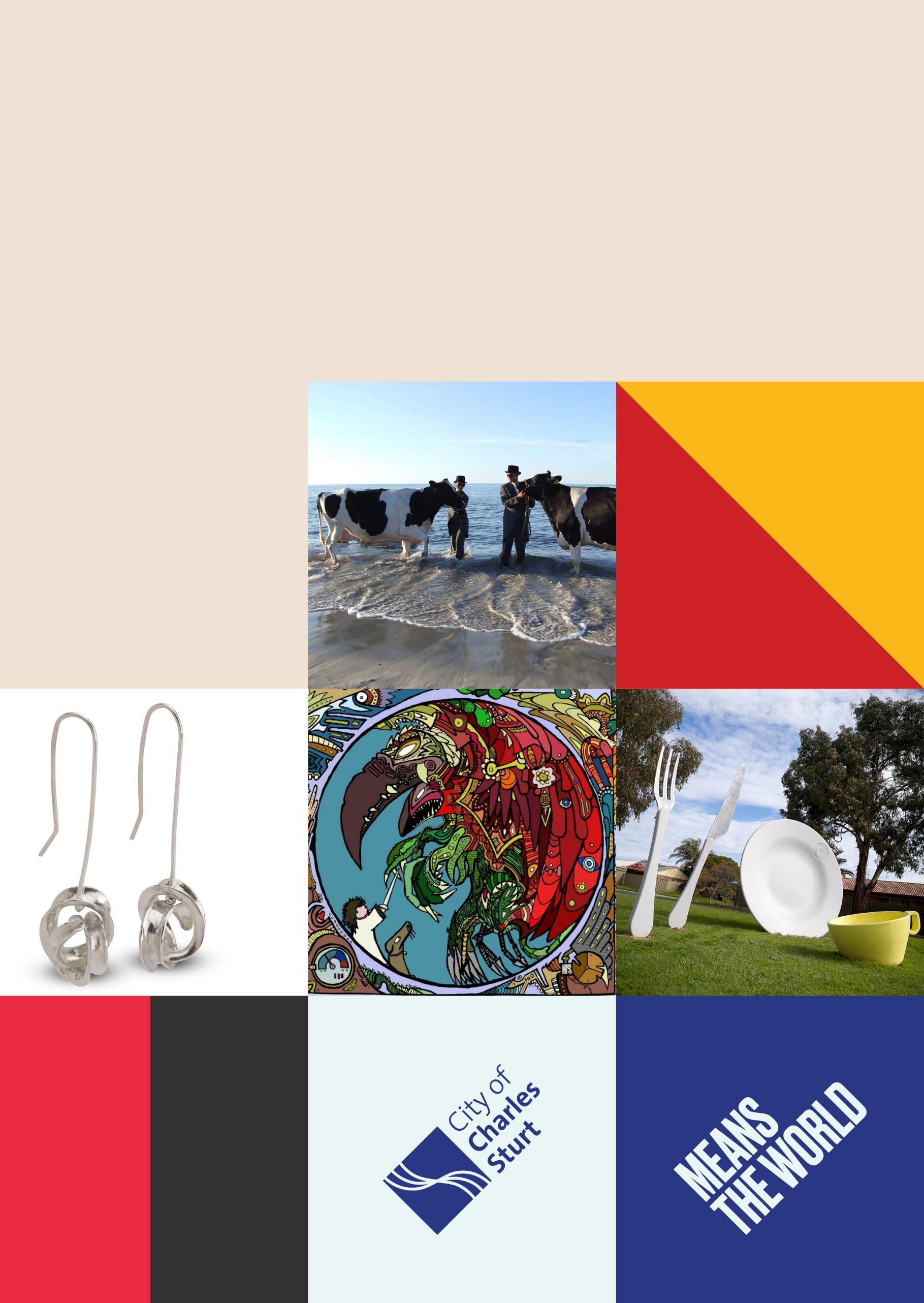
















Kumarninth Aboriginal Art Program and Immersive Cultural Experiences in Schools
Settling in at a local café after arriving on his skateboard, Tjimari shared his creative journey that started in a friend’s home studio when he was a young teenager, where he learnt how to create silk paintings and ceramics. Tjimari has continued his creative journey creating silk paintings ever since. A year ago, Tjimari turned his passion for culture and art into a business, Kumarninth, where he shares stories and creative techniques with school students.
I started the business about 12 months ago Unfortunately, Aboriginal History isn’t a key element of the Australian curriculum, so, I thought I could create a program where I could go out to the schools and share useful and correct information about Aboriginal culture. There is also an arts component to my business, where we do silk painting workshops, murals, show people Aboriginal art and why it is important, the importance of not culturally appropriating someone’s or a groups artwork and engage students in a fun and active environment.
How does it connect creatively with the local community?
In addition to schools I work with community organisations every now and then who engage me to deliver workshops, such as silk painting artworks, that provide a different avenue for me to be out in the community.

The silk painting, as it is different and unique and able to engage in Aboriginal art through a contemporary form so that brings in a lot of people. I can’t tell you how many silk paintings I have created over the last year. In the last week I have created nine silk paintings measuring 2x1 metres and I use habotai silk for the main fabric so the final product is amazing,
What is the hope for Kumarninthi’s future?
I am looking at a few different things around how to implement some of my educational programs to online platforms. It is still just an idea at this stage. Growing the silk painting workshops, bringing out new designs and new structures, it is still very early days and I will be sitting down to think about the plan for the next 12 months.
What actions would you like to see included in an ambitious arts and culture plan for our city?
Actively engaging a lot more with the Aboriginal community in terms of the arts sector, whether that is visual art, music or dance. There is a lot to offer such as pop up shows in Henley Square or brightening up the council area with lots of murals
Both times I have worked with Council I have found it pretty smooth, in terms of submitting a Creative Cities grant or a quote and design concept. The application process itself is straight forward and the communication was good. A lot of artists wouldn’t know the grants are there Maybe a link on the website with potential sites that could be brightened up or artists could do something, then they can go and check it out before putting in an application and see what spot suits them.
How might we ensure diverse stories are heard?
Something as simple as organising community nights where the community could come along to an event held by the Council where they get to learn a bit more about silk painting, education session, dance, could be a great way to actively bring the community together to engage with each other as well.
If running an event, ask the artist how they would like to run their session and what works best for them when delivering to make sure they are getting the best engagement for the community. We need to listen to the artists to get the best engagement as possible and to support artist led events.
https://kumarninthi.com.au/
Storytelling is a valuable way in which we connect, learn from and understand each other, our land and our history. Through stories we create a sense of belonging and identity.
Culture is created by community. Artist led projects and initiatives offer unique and creative ways to connect, challenge or inspire our community and provide creative solutions to challenges facing our neighbourhoods.
How can we more authentically and creatively engage with our local Kaurna community?
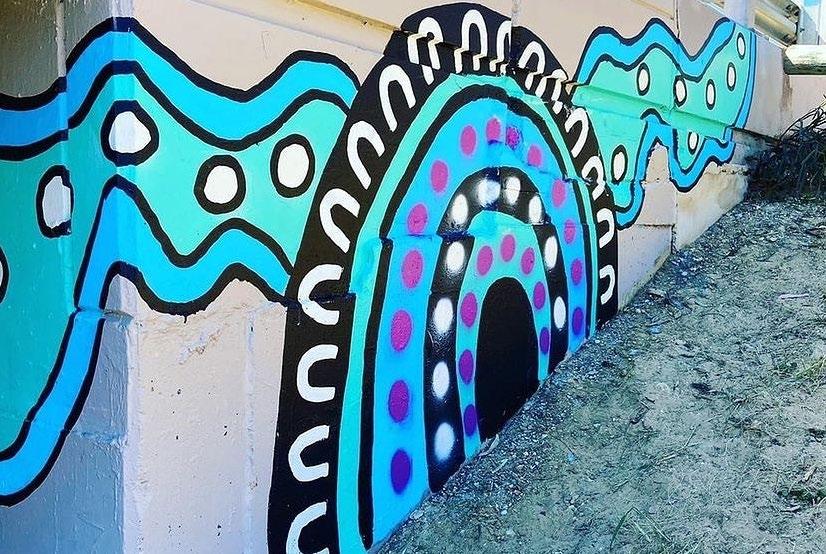
How can we better value, develop and support artist’s unique contribution?
How might we ensure diverse stories are heard?


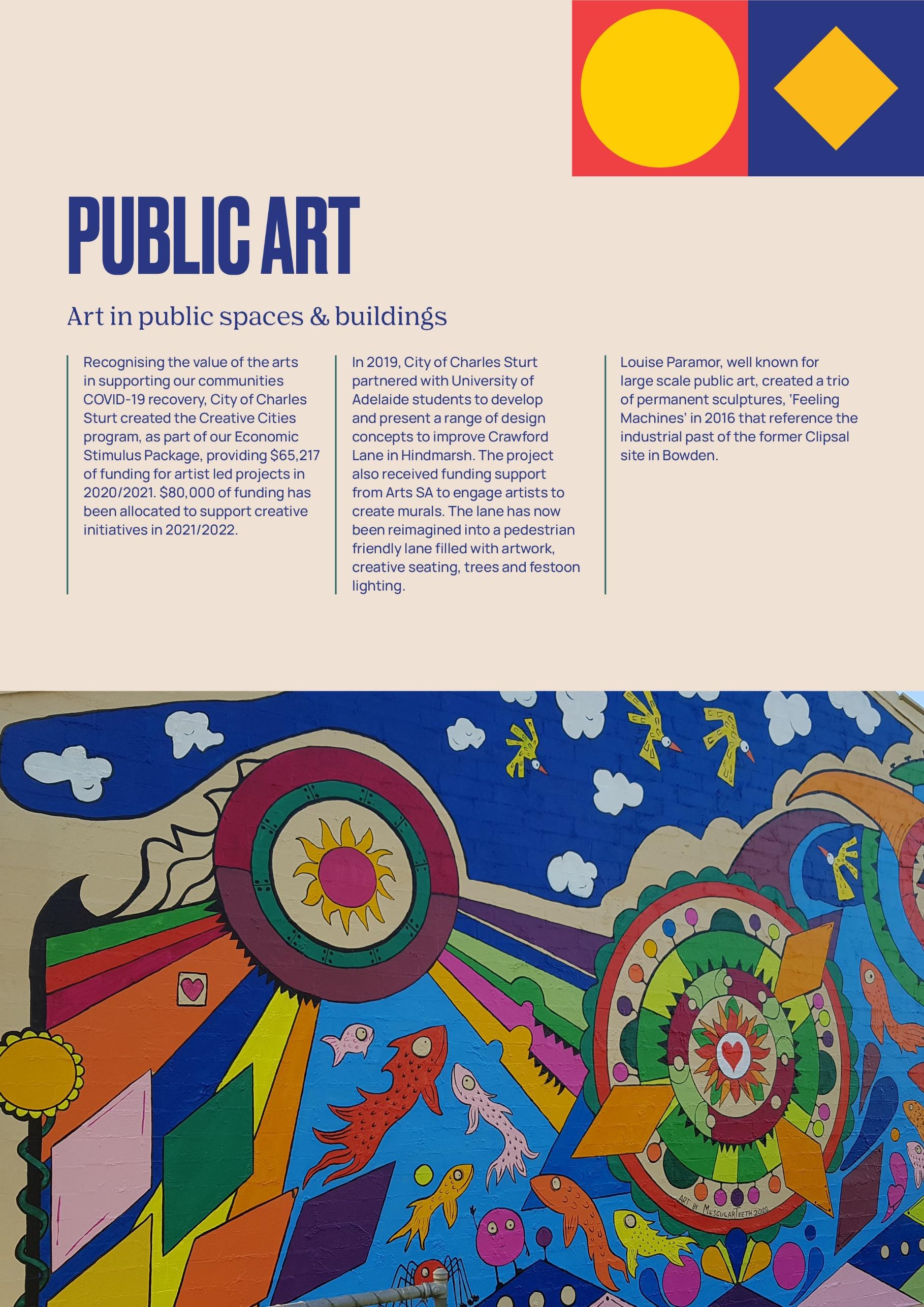
Muscular Teeth - Visual Artist –Public Art and more
Peter Grigoriadis’ home studio is a visual delight, with his intricately illustrated and colourful artworks adorning the walls. Sipping a cup of tea whilst peering out onto the winter garden makes this a creative haven to join Peter in a conversation about his art practice.
How would you describe your art practice?

Whimsical, funny, colourful, intricate, therapeutic in many ways, light hearted with a bit of humour. Most often I create works on canvas or paper as it is an easy media to work on and to translate to digital media, making it easily shared. I also work on murals, I write music and do photography, I paint on metal and steel, like saw blades and I also work with wood, but mostly visual art.
Why do you create public art?
In 2008 I was working 15 hours a week and all I was doing was churning out art, I was making hundreds of artworks and making sales online. But I felt that I wasn’t a real artist if I hadn’t done it in the real world. So, I went to Hindmarsh Greening and spoke to them about painting a stobie pole on my street. Then an opportunity came up to paint the Croydon Station, so I jumped into that and really enjoyed the process. I recently painted a mural at Trust reserve. It was during school holidays, so I had all these kids come out. First day I met them and had a good time, the second day I bought some pieces of wood and gave them paint brushes for them to sit down and paint. On the third day I drew some outlines and got them to colour it in and said to them now this is your wall, so they took ownership of it
The wall at Trust reserve was getting tagged, but since painting it back in June it hasn’t been touched, so Council doesn’t have to pay for any anti- graffiti clean-up
We lack colour and vibrancy in this country, everything is black, grey, primrose I know that because I make windows and doors in aluminium It is boring and there needs to be more colour. Bright colours are happiness, it is universal and can bring people together
What has been key to your success?
Compassion, perseverance, philosophy I don’t get into art just to sell things, it is a way of life. We are here once, you don’t get a second shot at it so you might as well do something to leave a legacy behind. You need to find your own meaning, and my meaning is the human contact with people, bringing joy, expressing myself without hurting anyone.
How do you see your art evolving in the future?
Bigger murals, more opportunities and maybe painting on weird and wonderful surfaces, maybe a car one day or on work boots. How I see it evolving is getting better I am fortunate I have a job and work 6 days a week but I am unfortunate that I am time poor. What I often then do is churn out easy stuff as it is easier than spending 40 hours writing a single drum beat for a music track. You can invest a lot of time in something and not get much for it or you can do simpler things and get a bigger bang for your buck so to speak. I do know I want to do it more and in more areas. I love doing new things, and I would like to try jewellery making, tailoring, leathermaking. I love to create.
What actions would you like to see included in an ambitious arts and culture plan for our city?
Open square areas or venues where people can congregate and do things to meet and meld. Something like a maker space where you can become a member and have access to cheap materials, although it needs someone with a wage managing it. This is where it gets into fantastical land. Or a maze of panels where people can paint a panel and someone else can paint over it in a few months, so it is always changing. Intentionally do public art with permission.
https://muscularteeth.com/tag/street-art/
Public art engenders a sense of community pride and connects communities.

Mural projects can provide a sustainable approach to prevent graffiti and improve streetscapes.

How can we support temporary public art across our city?
How can we connect local artists to creative opportunities, mural locations or projects with our community?
How can we connect with artists to help create more interesting public spaces?

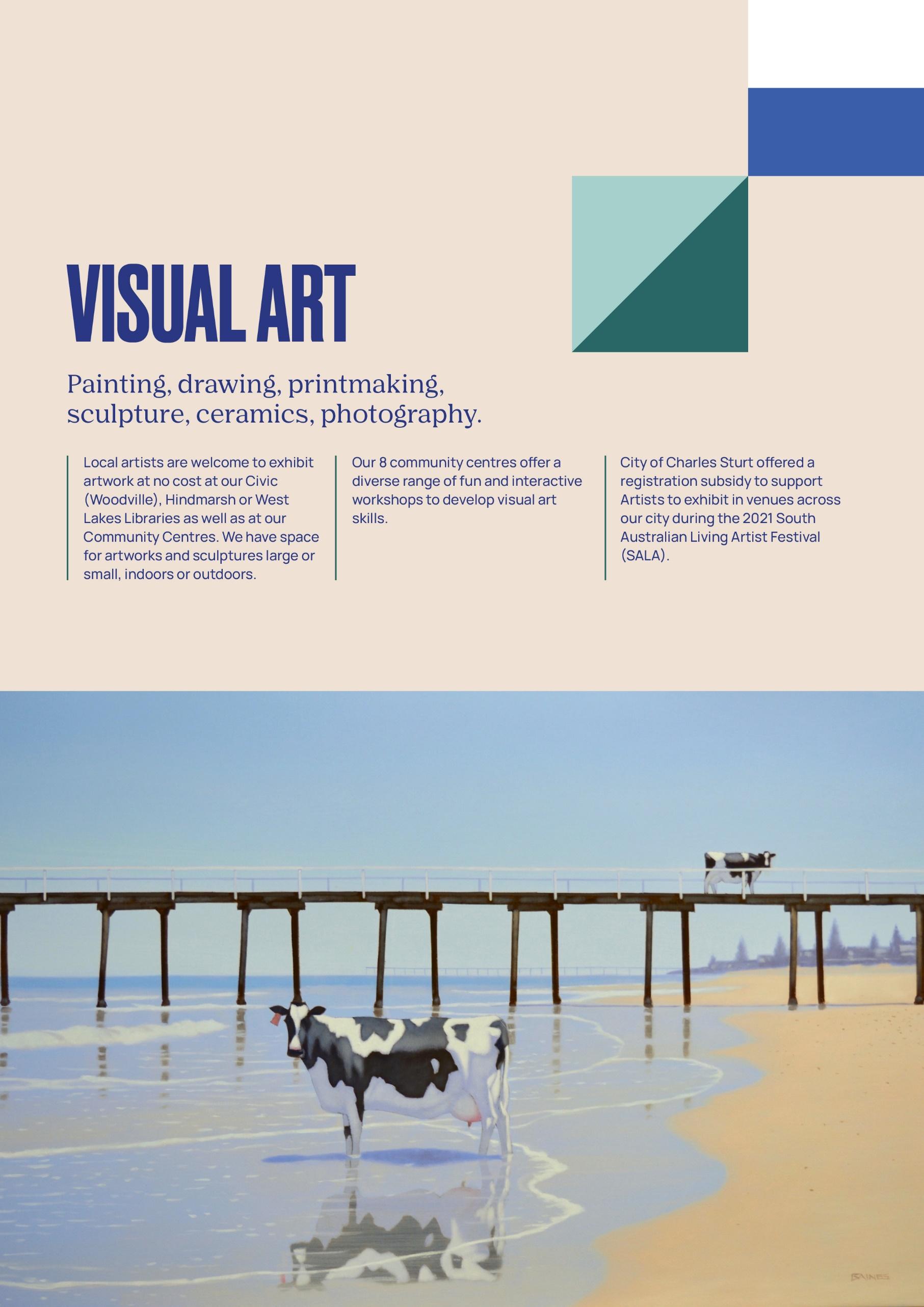
Praxis Artspace, curated contemporary exhibition space and studios
As I walk through the doors of Praxis ARTSPACE to meet gallery owner and Director, Patty Chehade, I am struck by the colourful works of exhibiting artist Dan Withey, whose works are a testament to the contemporary, experimental, multi-media and immersive experiences on offer at this Bowden gallery and studio space.
How and why was Praxis Artspace created?
After graduating (BVA Hons from Adelaide Central School of Art) throughout my Art History education I noticed that historically many successful artists seemed to be part of a group working together. Not only with visual artists, but across all platforms, such as writers and philosophers, and they seemed to somehow be more creative when they were working with each other. If I was to be successful in the Arts world, I would have to set-up something collaborative. I came across this building in 2015 and thought I would start an artist run space
How does Praxis Artspace connect creatively with the local community?
We attract a lot of locals who love the experience of coming here and we are starting to get a lot more families, particularly when we have the more immersive work that invites the viewer to play with the work
We also offer opportunities for emerging graduates from Helpmann Academy and Adelaide Central School of Art to have a free space to work in. Everyone needs an opportunity, like any other graduate course when you get to the end there is never an automatic lead into where you want to head and all a sudden you are out there. It is nice to have a little bit of support and be amongst other creatives.
What has helped Praxis Artspace to succeed?

The creativity of the artists is engaging, it is something new and exciting for people. It is lovely to have that
opportunity for the community to experience something that is a little more interesting, engaging and immersive. Even though we may not get a sale today it is an opportunity for the artist to have that platform to be seen and then they will move on to better things, such as, Kate Bohunnis, the current 2021 Ramsay Art Prize winner, who showed at Praxis Artspace in 2020.
What is the hope for Praxis Artspace’s future?
My hope is for at least six months of the year to have regular artists exhibiting regularly, rather than trying to curate something each month. It will be an opportunity to develop and embed the career of a select group of artists. We would also like to promote the artists enough that they are being noticed and supported by peak institutions Offering opportunities and a platform to be seen gives them the confidence and motivation to try new things and maybe noticed internationally.
How might the cultural sector work together to identify cultural and creative opportunities?
Making connections is probably the most important thing I think there is an opportunity to perhaps share exhibitions across the States and make those connections.
What actions would you like to see included in an ambitious arts and culture plan for our city?
Council could sponsor a studio each year Artists at the end of the day are struggling to financially make ends meet, so a sponsored studio enables artists to access the opportunity based on their credibility, not whether they can afford to pay for the studio.
I think artists lead the way in terms of finding interesting ways to develop a space, maximising the utility of an area and appreciating it for what it is. I think that is a really crucial privilege that we have as a state and community, rather than art just for individual benefactors. There is also an opportunity to support curators. One of the early curators, Joanna Kitto, secured a role as one of the curators at Samstag Museum of Art. https://www.praxisartspace.com/
Surrealist painter
Henley Beach based artist Andrew Baines has gained national and international recognition for his surreal photo shoots and inspired paintings. I met Andrew in what he calls his office, Joes at Henley Beach, to enjoy an inspiring conversation with a talented and established artist.
How would you describe your art practice?

It goes around in circles I come up with a concept My trademark is to have people in the ocean with bowler hats and umbrellas, reading papers or doing something corporate, and I invite the community along to a big photo shoot I then create the paintings from the photo. It keeps evolving, from business men, cows, dash hounds and sheep. I also involve high profile people, such as Alexander Downer, Malcolm Turnbull and the Adelaide Symphony Orchestra. I work with several charities and my work is often driven by social themes. The beauty of it is that I bring so many people from different areas to one place and it helps attract people to the local cafes.
What has been key to your success?
Doing what I want to do I have my own niche ideas and don’t chase dollars, and people come on board because they can relate to it. That is the secret to art, to have a niche. Mine is cows and business men. The International dairy convention approached me to have a cow exhibition, but I said that we could make it more interesting by putting cows in the ocean and give them a bit of rest and relaxation and a break from their milking. The cows loved being in the ocean. They were in there for an hour and didn’t want to come out.
How do you see your art practice evolving in the future?
Keep going and hoping for better ideas. It is about making people step away from reality - forget about the football for one weekend or the shopping and forget about all your problems and get lost in my world.
What actions would you like to see included in an ambitious arts and culture plan for the city?
A surreal exhibition on the beach. We could have easels lined up of individual artists and they create a work that responds to the theme of coffee and make it a competition. The winner could win a year of coffee from a local café like Joes at Henley Beach. Imagine a Sunday morning and 100 easels lined up with paintings of coffee and everyone dressed up like they are going to an exhibition opening. It is such our culture. It could be an annual competition and Council could hang the winning artwork in their reception area. It is so quirky and so simple.
To celebrate significant days, such as Harmony Day, we could also highlight food precincts through organising a cultural food march along Grange road or other precincts where there are numerous multi-cultural eateries The event could include chefs followed by school students dressed as mini chefs, along with music performances from different cultures.
One idea I had is to put a concrete cow under the Jetty so when the tide goes out people can see it, or when it is submerged dive into the water to view it. It is about life changing. In theory these ideas sound good but there are often several different boards and people to gain approval from that it becomes impossible to do. What is needed is someone in Council that can advocate on behalf of artists and connect with State or other boards to gain approval.
What do you see is the role of the arts in our community?
Artists working with charities can raise awareness of the charities in creative ways. Creativity is also like mediation I speak to loads of people who have lost their jobs and they start painting on a canvas and five hours later come back to the world and they feel great. Art is great for the soul. http://andrewbaines333.bravesites.com/
Artist led projects can assist us to raise awareness of community issues as well as celebrate significant days in creative ways.
Improved connections across our creative sector, artists and Council can assist our community to grow creatively and help to shape our spaces and places.

How can we partner with our local galleries and creative businesses to support emerging creatives to build their creative talents, skills and sustain their art practice?
What unique, high profile art initiative can we deliver with our creative community to attract visitors, raise our profile as a liveable city and increase civic pride for people living in Charles Sturt?
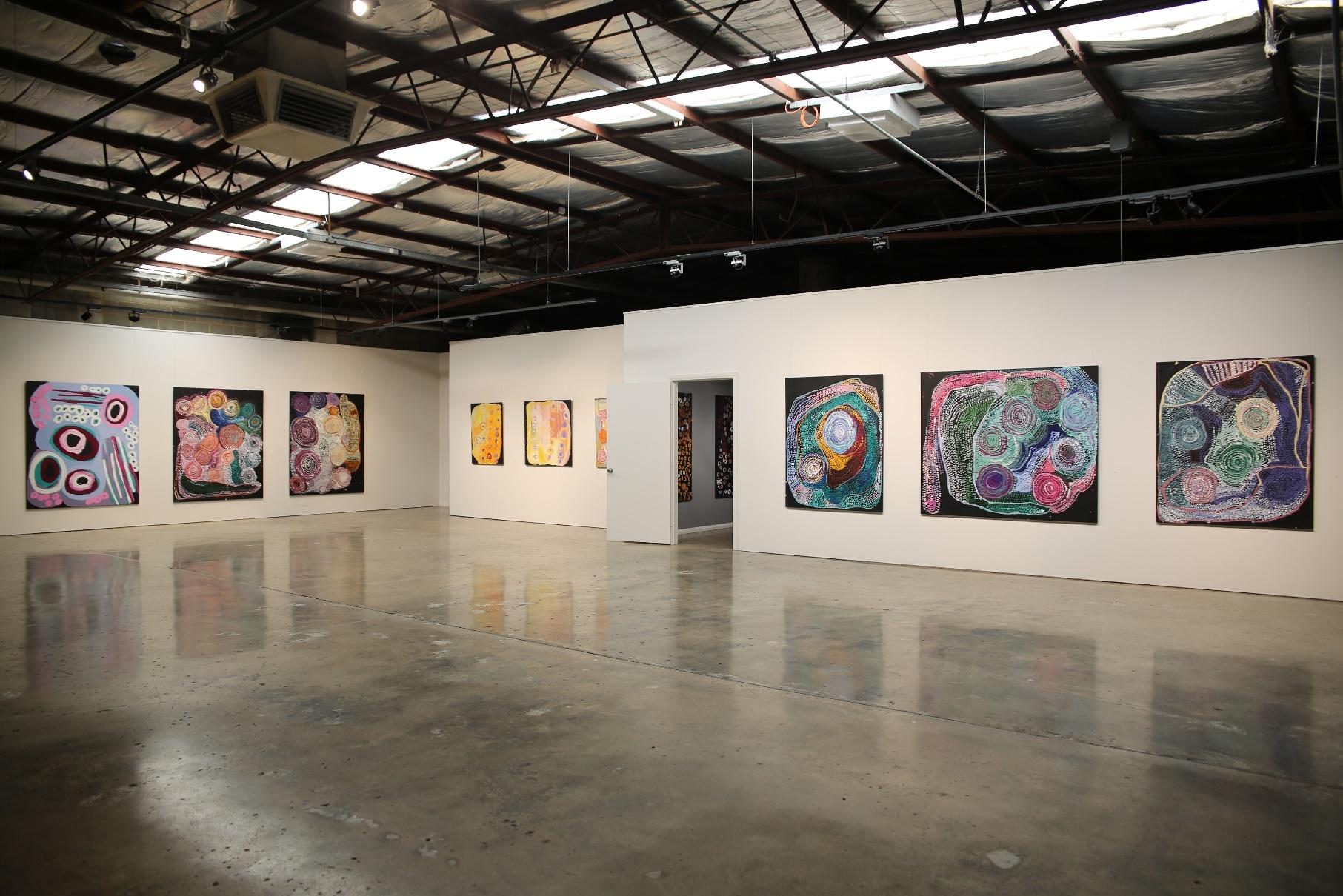


Holden Street Theatres, part of both the Adelaide Fringe and the Edinburgh Fringe festival landscapes since 2003
Martha Lott is the founder of Holden Street Theatres housed in the heritage Church complex in Hindmarsh. Since the first production in 2003, Martha has toured over 75 shows from Edinburgh Fringe to the performing arts theatre complex. I met Martha in the recently refurbished creation hub at 32 Holden Street. An hour with Martha was clearly not enough to capture the countless stories and insights from over 30 years' experience as an Actor, Director and theatre founder in SA, NSW and the UK.
After studying acting in London I moved to Sydney before returning to Adelaide in 2001. I watched the industry for a year to see how, as an artist, I could fit back in. During Fringe 2002 I created the first temporary multi–time slotted theatre venue. It was very successful, so I thought I would build a theatre and in November 2002 we signed a lease at Hindmarsh
What has helped HST succeed?
Holden Street Theatres is a family, consisting of hundreds of artists both local and international, an active volunteer group of 60 people and over one hundred of Friends of Holden Street Theatres. We support emerging artists to do experimental work during the fringe, providing four weeks free rental and a Holden Street Theatres Edinburgh Fringe Award that tours an outstanding piece of theatre over to Adelaide - the only award to tour work to Adelaide from any Fringe in the world.
The original vision for the theatres was to create work for local artists but it has become much more than that. Our community get to be part of the process, they meet the artists, can work with them and help on productions. Every time we have had an issue, like COVID-19, we find people flock to the Arts because it makes them feel better It speaks heavily to mental health and wellbeing and makes
people hopeful and positive about the future.
What makes HST unique?

We have toured over 75 shows from Edinburgh Fringe, shows from America, South Africa, New Zealand, UK, Ireland, Norway and Scandinavia. Our local artists have been exposed to those techniques and artists, developed friendships and created work together. We also exchange workers between Adelaide to Edinburgh Fringe and have won over 80 Fringe Awards.
What is the hope for HST’s future?
Our hope is to create more work in-house and offer the venue for emerging artists, unfunded or mid-career artists so they could get a step up and we would still be the venue for hire and continue to do the fringe program. We are also hoping, during Fringe, to live stream international performances in a deluxe lounge area so people can have a glass of wine, dinner and watch a beautiful piece of theatre from Chicago Shakespeare company, followed by a live piece of theatre from a local artist.
What actions would you like to see included in an ambitious arts and culture plan for our city?
If we want to become the Council to move into for Artists, arts workers, creativity and community connections then we need to advertise the attractions of the area. The Arts then become part of the everyday vocabulary.
There is a lot of trepidation for artists and people in the industry at the moment to take risks and be entrepreneurial because there is no surety over what is going to happen. The arts and culture sector as an industry is important in the landscape across the whole city and we need to understand why it is important and Council to take a lead role, be behind us and use the arts to encourage people to keep or setup businesses here to create a vibrant city. It is a big city. If everyone has a little bit of the arts resources then everyone will struggle, perhaps focus on key areas. For instance, in Hindmarsh, celebrate and concentrate efforts to build the reputation, impact and attract more arts into that area.
http://www.holdenstreettheatres.com/
Rumpus Theatre, community of professional independent theatre makers facilitating thrilling and innovative new theatre in Adelaide
Rumpus takes me back to an aesthetic of old Australian suburbia, picture RSL hall meets your grandmother’s living room. Sitting amongst the welcoming and inviting eclectic mix of vintage furniture I met with two of the theatre creators of this artist led space, Rebecca and Nescha to hear how their first two years of operation has gone and their hopes for the future.
How, why and when was Rumpus created?
In 2018 a group of artists and theatre practitioners got together to work out what was missing in our industry, specifically as independent artists, and what we could do as a community to fill those gaps. Something that came out of those meetings was the desire for a home ground, a shared space that could house independent theatre. The opportunity of this space came up and it was a great deal, so we took the plunge and launched a season of 4 shows of independent artists in mid-2019
How does rumpus connect creatively with the local community?
We have a membership of roughly 50 artists who help contribute to make us run and pay the bills. From those artists we branch out to the broader community. For instance accountants that can help us out and have a desire to see the space succeed and see a need for it in the arts ecology. Everything we have is thanks to our community that have helped make this happen. We have provided a space for people new to the industry looking to find their feet in the professional world, anchor in a community or start a company
Rumpus is an accessible space for them during those initial years that are particularly hard, a space where they can make connections with other artists and learn skills. Bringing a community of people together that otherwise would have been isolated.
Artists typically end up working for free, so we are trying to avoid that. As an organisation we are working toward getting multi-year funding or other modes of becoming more sustainable. Whilst maintaining it as an Artist run space, where artists are the decision makers and pay people for specific organisational roles to free up the Artists to work on their practice and build the industry.
What actions would you like to see included in an ambitious arts and culture plan for our city? Visibility of the opportunities available and appropriate names of Council grants so Artist are aware the grants is for them. At a State level it is easy. They have an arts department and that is where you go for funding information.
Promote external opportunities on Council website and Council grants on art social media channels, like Helpmann academy or Carclew. Artists often don’t think about Council funding and that Councils are willing to help.

Understanding what arts means to community life and culture building that a show can have. We talk a lot about community, but when we look at funding guidelines, we often don’t fit community criteria because we charge audiences to come to our shows.
In funding environments where it is not art specific an understanding of how much it costs to put on theatre sometimes isn’t there. A one person show still has at least five people working on it and the need to pay people properly, resulting in a better understanding of what artists are asking for when they apply for funding.
Access to unused spaces is another Our calendar is filled with artists wanting affordable rehearsal space and we are having to turn people away. The demand is there.
https://www.rumpustheatre.org/
The Governor Hindmarsh (The Gov), award-winning live music hotel hosting artists of every genre
Melissa Tonkin’s family have supported the live music scene for decades and Melissa continues this legacy. The Gov has resisted installing tv screens and pokies, instead we are greeted with a timber bar, cosy lounges and a fireplace, maintaining the charm of this iconic live music venue.
After moving from Victoria in 1980 and running various hotels, my parents really wanted to give something back to the music scene. It was 1993 and a lot of music rooms were being transformed into night clubs. My parent’s plan for The Gov was to have a pub with a big music room to give something back to all the musicians that had supported us over the last 12 years. In 1997, my sister Jo and I started to take over the running of the hotel and the potential was there to bring more variety of music. We also extended our venue, built a new stage and put a state-of-the-art system in. Paul Kelly and other east coast artists started to realise what a great room it was and how dedicated our family was to live music.
We really wanted to have a melting pot where musos from different styles of music could come together in a hub and share ideas and jam with each other. Whether it is blues, jazz, Irish players, ukulele players, Blue grass Cajun jammers, they come weekly or monthly and have their regular events here. We encourage anyone who wants to play to pick up an instrument and join in
Success is in its longevity and passionate people, this has been our life’s work because we love live music. A lot of our smaller events lose money but that is what makes The Gov
what it is. The big touring acts that come through are what helps us to get the funds to support a lot of the smaller community events we want to do. People have known us for a long time. We care about all the musos that step through the door.
We have 3 performance stages going on at once so at any given night you can come through and there will be an acoustic duo in the front bar, Irish players jamming on the upstairs balcony, an open mic night and then in the venue you might have rock and roll with 3 bands. We have people from all walks of life, we don’t seem to attract just one type of person, always different age groups and interests. You never know who you are going to bump into at The Gov.

We also have a lot of schools do their annual show at the pub, and that is something I want to more of here. I think having young people play on the stage at the Gov, they know that musos they admire perform here and tour here and for them to be able to do a show on the same stage is inspiring. Next generation of our family is coming through, who are taking on different roles in the Hotel, and we are wanting to do more to bring young people through to experience music. Work with schools and run workshops to make it available to more people who haven’t had a chance to access it.
Working with local musicians to bring music to areas of the community that otherwise wouldn’t have access. It gives employment to the musicians and benefits people in that situation. We are not educating young people enough on how to appreciate music and need to develop that passion at a really young age and they will be the ones supporting live music in the future.
A map of local attractions that lets you do your own journey, how to plan your perfect day in Hindmarsh, ride your bike along the river and see an exhibition, coffee at plant 4 and then a pint of Guinness at The Gov. https://thegov.com.au/
Arts and Cultural organisations that connect artists and develop creative potential are the incubators of our vibrant, creative and liveable City.
Performers need affordable spaces for rehearsal.

How might we engage the next generation to get involved in the Arts?
How might Council use its marketing resources to enhance the visibility of our cultural and creative life, encourage people to connect to the arts and build our brand as a creative and liveable city?
How can we creatively encourage visitors to explore and experience local arts and cultural attractions across our City?
How can we improve the promotion of our funding opportunities and funded projects to raise awareness of how we are supporting the arts and attract applications from artists and local venues?
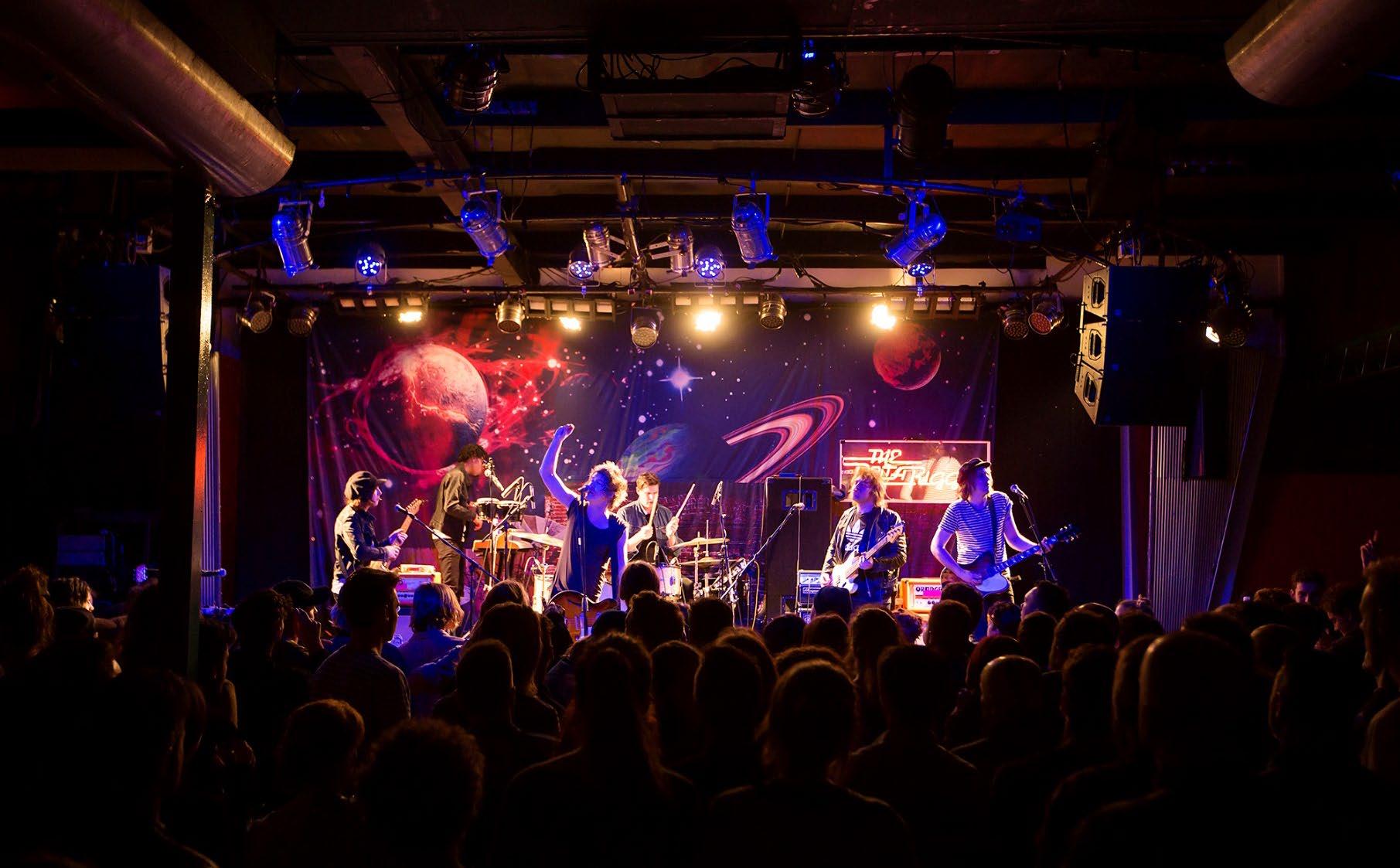

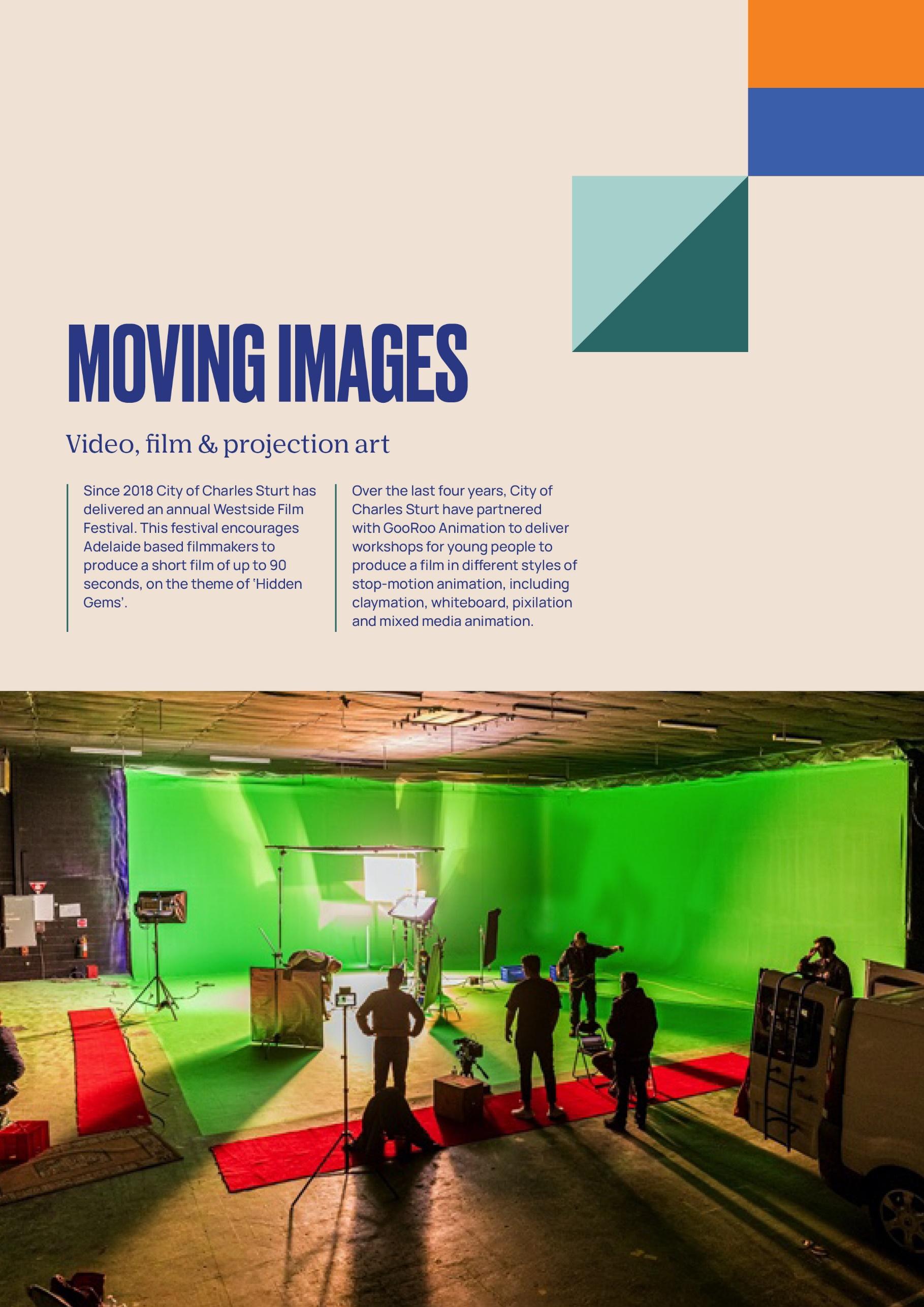
We are fortunate to have Australia’s largest privatelyowned film studio complex in our neighbourhood. There is a hive of activity as I stepped into the studios, as sets are being taken down and stories being shared of the latest film production to be supported by this creative and innovative place.
From approximately 1981 until 2013 the studios were run by the South Australian Film Corporation. An advertising agency I own called Anomaly then took over the running of the facility until that business was subsequently split up. Then, at the end of 2020, the building was sold to Victorian investors. Mid this year I was brought in as a consultant to the new owners, as with the growing issues with travel due to COVID-19 they needed someone on the ground in South Australia that understands how the studio works and understands film production.
The studios support a range of productions from small scale one-day commercial production and corporate videos to large scale TV series such as Wolf Creek and Anzac Girls, as well as films such as I Am Mother; the Hilary Swank film. We are currently expanding our post production from foley work to include picture editorial and post sound in the broader sense with a new Dolby Atmos near field mixing theatre, which will be the best of its kind in the state and will allow streaming and home video mixes that do not require a big theatrical mixing theatre. It will be a great resource for local and interstate filmmakers to produce mixes for Netflix and Stan amongst others. In addition to the two studios, we have 25 offices and we would like to bring in all kinds of businesses - not just artists - who want to work in a building that is fun, exciting and different every day.
Private investment, as the facility has seen no support
from the government thus far. Everyone sees the potential of the studios, but you inevitably run into the problem that is across the industry in South Australa; that we do not have a lot of crew here and have a serious skill shortage problem. So, we lose a lot of South Australian productions to interstate because we don’t have the crew to service them, or we lose interstate productions that don’t come here because we just don’t have the crew, or crews just leave because there isn’t enough work here.
What actions would you like to see included in an ambitious arts and culture plan for our city?
The scope of the finances required and what we are trying to achieve in the film industry. For instance setting up a film school to begin to address the skills shortage is probably beyond Council’s reach. Certainly one thing that could help is to assist us to fill the office spaces here, as that baseline revenue helps us invest more in the arts and assists smaller films get made that otherwise would never get made.
To unify the arts sector in Charles Sturt, the studios should be a centralised arts hub, as we have a lot of space, resources and networks to help things come to life. It doesn’t have to be film. We have had artists create murals on huge canvasses who just need the space to do that, or whether it is space to do workshops, dance rehearsalsanything at all.
The gap in the market here is skills. Some plans we have are to cross skill people who have been displaced from the theatre industry because of COVID-19, as they have a lot of transferrable skills that can be applied to the film industry with a minimal amount of training. This helps the artists, the film industry and the state because of the economic multipliers of having films in South Australia is about three times of the spend that we get back. Everyone wants to work here but we can’t support that work. Our crew depth at the moment is around three, which means we can run three 5-million-dollar scale feature films at once, so our five-year plan would be to get this up to around ten.
https://sunjivestudios.com/

Tailored training for new and existing production crews could assist to strengthen the local screen industry position to secure more local, interstate and international projects.
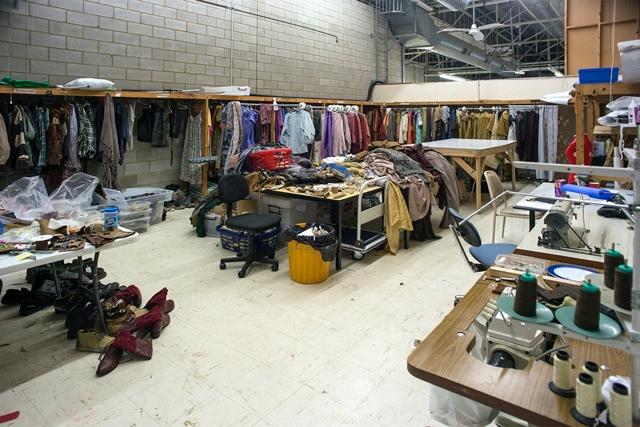
How can we support cultural and creative sectors to work in an inter-twined way with different sectors adjacent to their own, with completely different sectors, or in a cross-sectoral way, to develop entrepreneurial and innovation potential of the sector and nurture innovation and skill development?


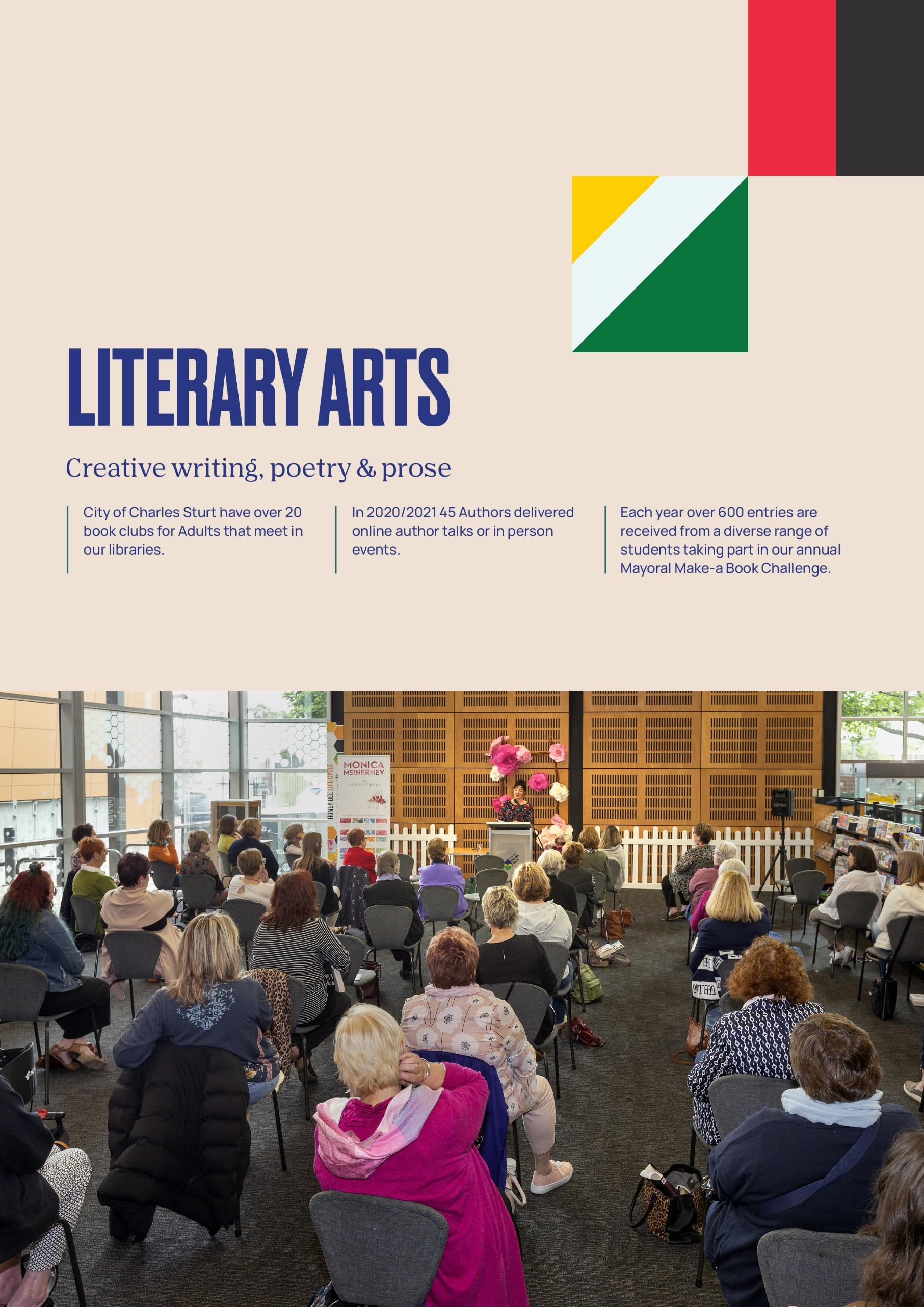
Kate is an articulate, inspiring and passionate writer whose published works are available through our libraries. Kate is a member of the Henley Scribblers, who meet fortnightly at Henley and Grange Community Centre. Originally joining the group to improve and grow as a writer, Kate gained more than she expected through exploring and experiencing writing in a group, rather than purely as a solitaire pursuit.
My father was a great linguist, having studied English at University Growing up he espoused a lot of poetry and Shakespeare. My mother was also a great diarist, writing all the time. That background gave me inspiration and a foundation for my own career teaching English as a second language. In 2006 my mother shared with me her ledgers from the war and an album of photographs she took at the time as an amateur photographer. I thought this needs to be put together and published, but I was not really a writer as such, so I completed a creative writing course at TAFE TAFE encouraged me to join a writer’s group, and I joined Henley Scribblers in 2009.
Henley Scribblers was established by the University of the Third Age in 1989. We have supported each other through thick and thin and are very supportive of each other’s creative writing journey. Each fortnight we are given a topic to write about, usually just one word, which gives us an opportunity to be creative It is amazing the variety of stories and poems that are generated from that one topic. We then read each other stories to be critiqued. We have a mix of poets, short story and memoir writers. Creatively, it is a broad variety, so it’s interesting when you read and hear other people’s stories and if it inspires you that is the catalyst to keep us going.
What has been key to the group’s success?
At least four of our twelve members have been published. We have just completed our 10th Anthology, they have all been well received. Along with my own books, the anthologies can be accessed via the Charles Sturt Libraries and are also available for purchase from the launch or through the Henley Scribblers. Our format of inviting guest speakers to run workshops with the group provides learning input all the time. That is the key to success and to not plateau; picking up new ideas and helpful tips and sharing knowledge across the group, such as IT skills to self-publish.
We want to keep going and include a few more people and have a place to meet without time restrictions as we are limited to 2 hours and have a waitlist at the moment. Our focus is to share stores and hear everybody and concentrate on getting our anthologies together. We also want to attract more guest speakers to keep the group evolving.
What actions would you like to see included in an ambitious arts and culture plan for our city?
Continue to encourage people to attend the various Author talks and workshops hosted by the libraries. As well as artist talks, more workshops on how to write short stories run by libraries. Perhaps we can broaden the workshops we run for the Henley Scribblers groups to the broader community by running them in the library.
A grant to allow us to publish more often. We currently self-fundraise. The small margin we make on book sales support the publishing cost of our next book, however we would like to engage a professional editor as this service is expensive so beyond the group’s means.
Years ago there used to be an arts launch, with various artists having stalls of works for sale, such as Henley and Grange Arts Society as well as Henley Scribblers. Be great to have an event to showcase different types of arts in our area

Creatively exploring together and working with others prompts fresh ideas and provides new perspectives.
Opportunities to regularly meet with other writers and share excerpts of work motivates participants to keep writing and to bring their best to the group.


What are the opportunities for our creative writing and broader community to connect with and celebrate the Writer’s Festival across our City?
As Henley Scribblers is at membership capacity, how can we encourage other writers to establish writing groups or have greater opportunities to network and connect with each other?


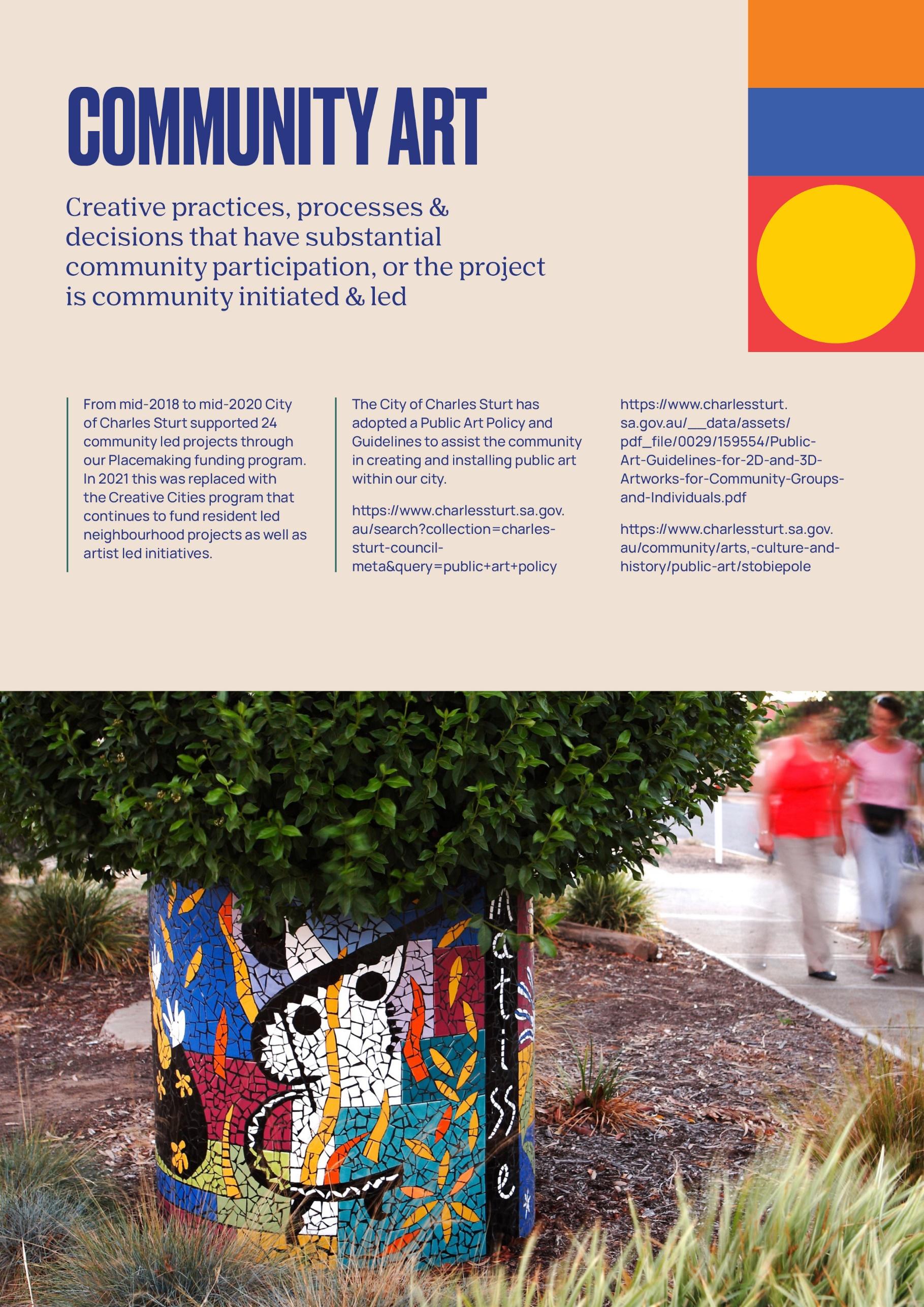
Stobie pole artwork, mosaic street flower pots and planting trees in the Hindmarsh and surrounding areas
As I travel to meet Cheryl I pass by Hindmarsh Greening mosaic pots and stobie pole artworks that adorn the local streets of Bowden and Hindmarsh and I cannot help but feel that this is a place where community building and a sense of local pride is valued and important.
In the late 1980’s, the Hindmarsh area was an industrial suburb, so with the support of the then Hindmarsh Council, Hindmarsh Greening was created to plant intermediate planting to keep dust down as well as verge planting. A few years later we started creating large mosaic pots and stobie pole painting to integrate art with our planting to add colour to what was a bleak neighbourhood. Our vision was to link Park Terrace over to South Road. In that time, we have created 36 mosaic pots, more than 70 mosaic stobie poles, hundreds of painted stobie poles and a number of sculptures in our parks. We also commissioned 9 decorative suburban signs to create a real inner west artistic identity
Our big picture vision and linking areas within our community. We take a whole of street approach to make the space more interesting and colourful. Great examples include Queen Street Croydon, Hawker Street, Ninth Street and Thirteenth Street in Bowden.
It is having pride in our neighbourhood, making people want to be here. The thing I love the most is our engagement with the community and their feedback. While there are changes to be made and appreciation for what we do, we will continue. We are very active with mosaic street art, which I think will keep motivating and growing the group. Continuity of membership and
understanding Council is a big factor and having a base at the Brompton Community Garden is most important, along with ongoing funding from our Ward Councillors. Mentoring other groups on how to successfully make changes to their local streets is a great opportunity for our group into the future.
What actions would you like to see included in an ambitious arts and culture plan for our city?
As an ongoing group we apply for funding through Discretionary Ward Allowance WA every 2 years or so. To avoid having to stockpile materials and supplies, it would be preferable for Council to allow us to spend the DWA over a 12-month period instead of the current 3-month timeframe
Public Insurance is going to be a big question for groups like ours moving forward. It is an obstacle for us to be involved in events like the SA Nature Festival and other events that require PL insurance and a risk during stobie pole installation. Generally, we won’t get involved as it is financially onerous to participate in outside events.
Bring together groups across our city, for instance all different community art groups to share stories, information on where to source materials, how to work together to get a discount from suppliers and support each other, e g time, space and resources.
Recognition and profile of community art outcomes across Council marketing platforms. Recognise our natural, historical, current and future assets that have potential to be the next Queen Street. This could be the Kilkenny area. Multicultural artwork along Torrens Road, music inspired works in Hindmarsh to celebrate our music history and live music venues.
Beautification of our city entrances. Artwork can be an anchor to set the imagination going of what is possible in an area. Identify designated areas for public art. Buy one large art piece every year and projected illumination art in Hindmarsh and other spaces.
https://www.facebook.com/hindmarsh.greening.7/

The cost of public liability insurance is often a barrier for our community to deliver neighbourhood projects.
Community driven projects create places that encourage social interaction and require many participants as possible so that they have the time, energy and ideas to keep things going.


What are the barriers for our community to lead projects in their neighbourhood?
How can we continue to support and inspire our community to create and grow neighbourhood projects?

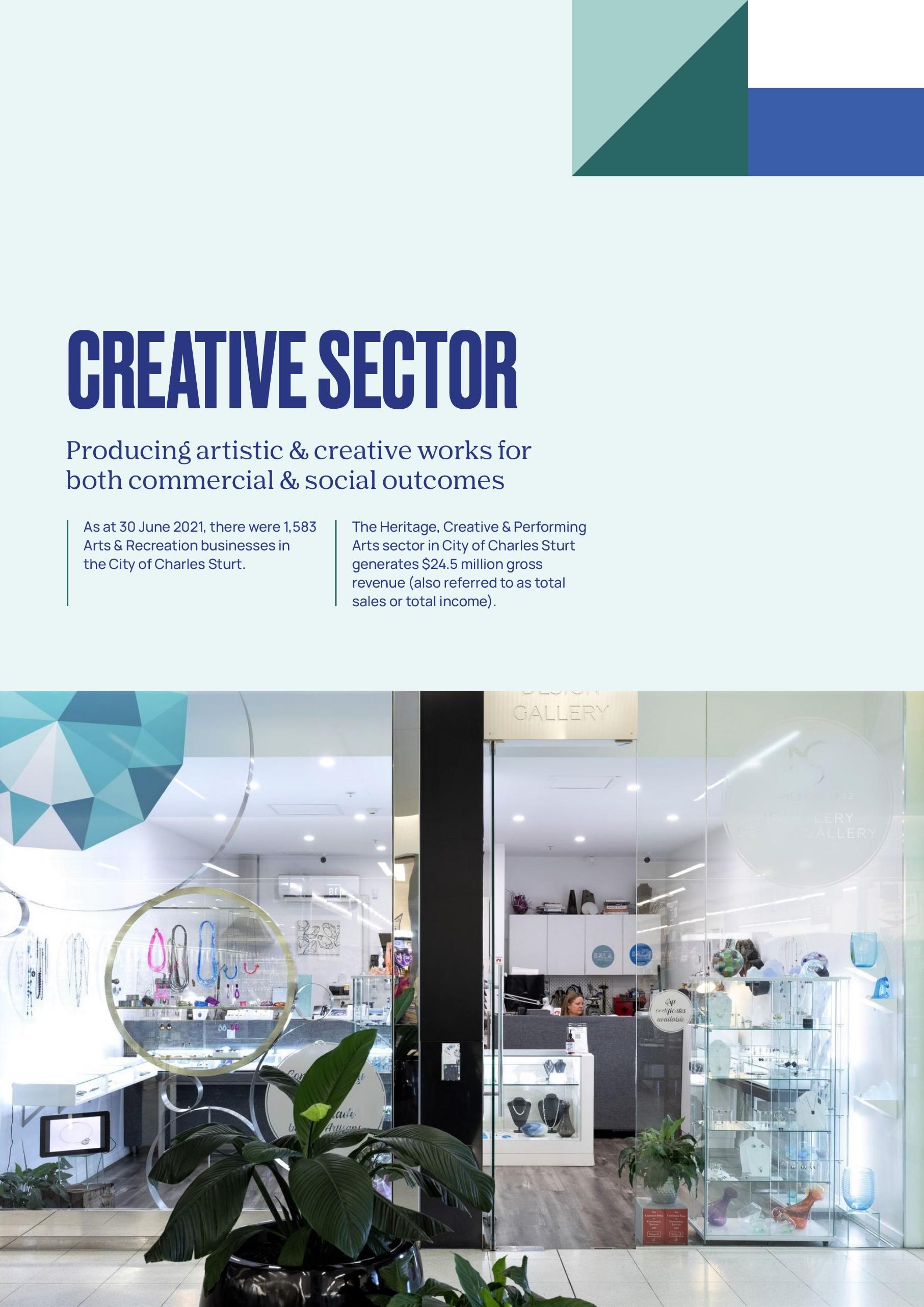
Bespoke Jewellery Designer, Naomi Schwartz
Jewellery Design Gallery
Walking into Naomi Schwartz Jewellery Design Gallery I am struck by the wide range of materials, from titanium, stainless steel, glass and even timber, skilfully crafted into bespoke jewellery pieces. The working studio lures visitors in to find out more about the South Australian artists showcased here and the stories behind each unique piece.
What attracted you to setup your jewellery design business in Henley Beach?
When I visit a seaside town, I always like visiting the various arts and crafts shops, whether it be jewellery or design, and see works of local makers. As a resident of Henley, I noticed that there wasn’t an arts space in the area that showcased South Australian Artists, so I wanted to create a studio and gallery where people can purchase jewellery and meet the artists. That was five years ago I make and sell my work from the gallery and currently support around 40 South Australian artists in the gallery. We have a great community of Jewellers in our State.
What has helped your business succeed?
The fact that there isn’t any other space like the gallery here. It is something new and different for the area. The locals have also been very supportive, we offer different price points and rather than go online people really like to come in and have a chat with the maker, touch and try on handmade pieces and work with us to create something custom for them, so we have lots of repeat customers. I have also focussed on attracting visitors through being involved in the South Australia Living Artists Festival (SALA) and partnering with local businesses (Henley Beach Business Association) to access grants.
All the artists have different styles and techniques and create their pieces from a range of materials, such as titanium, plastic, precious stones and metals. They also do small runs, it isn’t mass produced. We also have themed
based exhibitions throughout the year that challenges the artists to come up with something new.
What is the hope for your creative and business future?
More of what we are doing and to keep making!
What actions would you like to see included in an ambitious arts and culture plan for our city?
Promoting local makers and creative businesses is essential. SALA exhibitions and walking tours have been popular and great in attracting people from other areas, but that is just one month of the year. It would be great if we could promote walking tour experiences throughout the entire year. Perhaps a directory in the square, like the old Civic Guide boards but more creative or sculptural in appearance, or online, so it gets people out and walking around and seeing different things, such as galleries, restaurants and where to go to get your nails done.
We could start by bringing the creative businesses together to bounce ideas on how we could work together to promote our creative community.
I had an idea before COVID-19 to promote local Henley day trip experiences to cruise ships coming into Port Adelaide. They are ported here for the day and often head to the city, so we could try to get a tour bus to come to Henley for the day. Or arts bus tours that include dining experiences and visits to local Galleries, meet local makers and artists, such as Andrew Baines, an iconic artist here in Henley amongst other local studios and places.
The Brighton sculpture festival is iconic. We could do something similar here at Henley, but make it our own, perhaps an annual art show with competitions in the square. It would be great for a variety of artists, jewellers, painters and sculptors at different stages of their career to come together.
http://naomischwartz.com.au/

With the devastating impact of COVID-19 on the arts and culture sector, the Arts and Culture Plan is more important than ever in guiding Council investment and partnerships between State Government, local Government and the arts and culture sector to suppo rt a sustainable future for the benefit of our community.
Our creative sector creates jobs, build future entrepreneurs, drive innovation, attract investment, entertain audiences, boost tourism, enhance our wellbeing, and showcase our unique culture.


What iconic arts and culture event can City of Charles Sturt be known for?
How can we bring creative businesses together to bounce ideas, share skills and knowledge and promote what is on offer in our city?
How can we support existing creative businesses to grow and attract start up creative businesses within our city?

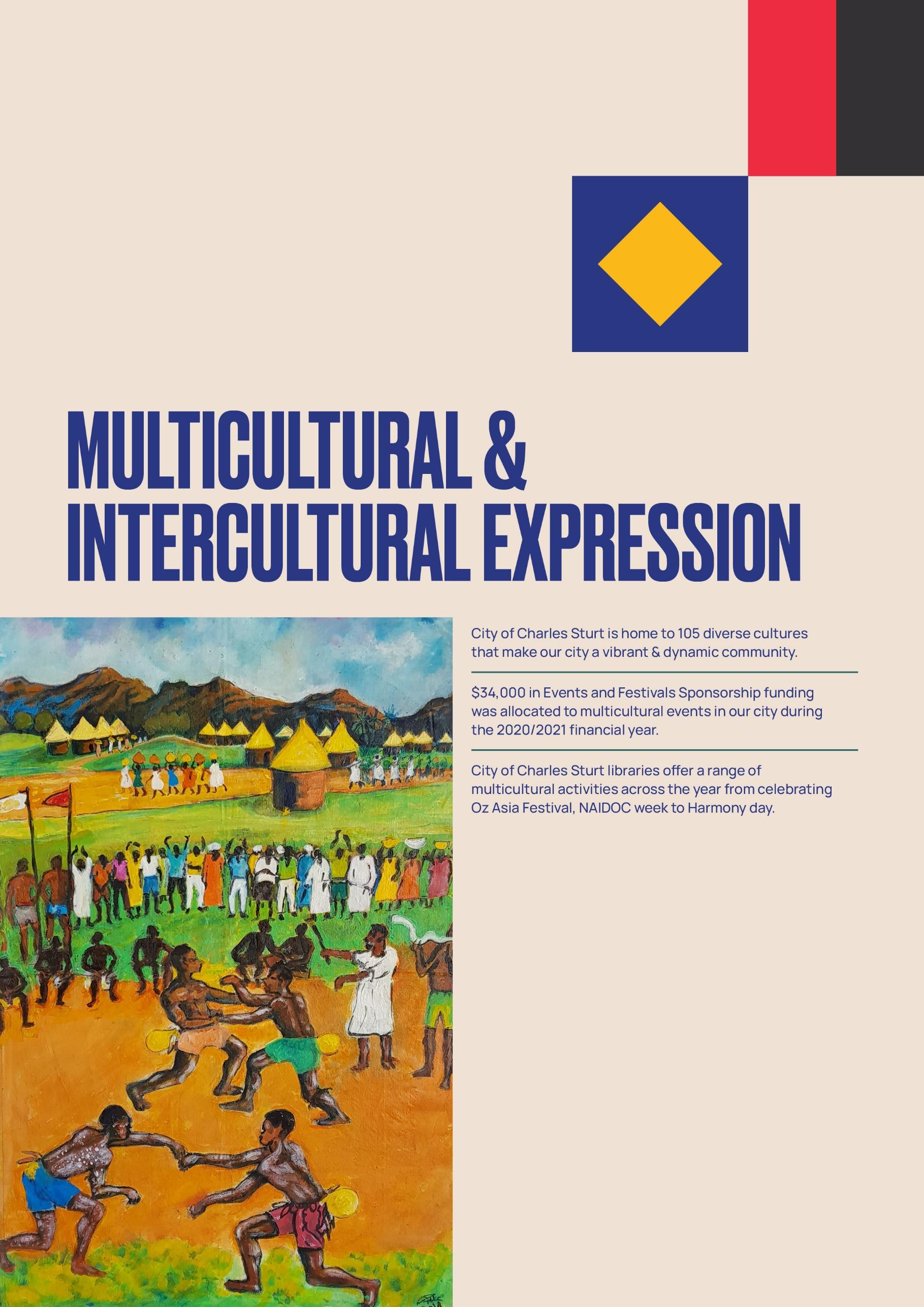
Nuba Mountains Association of SA Inc, Nuba Mountains is an area located in South Kordofan, Sudan and home to a mix of traditional African, Christian and Muslim people
Abdullah upholds the Nuba Mountain’s tradition of storytelling. Surrounded by images of traditional body painting, dance and wrestling alongside displays of handmade miniature clay huts and instruments, including a harp, I am honoured to hear Abdullah share his very personal journey and insights into the extraordinarily rich cultural practices of the people of the Nuba Mountains.
Tell me about the association?
It is a community organisation. I came here with my family in 2001 due to the horrible situation in the Nuba Mountains.
I returned to Sudan in 2005 but couldn’t go to my home because of the war and a relative advised me not to go there as I am an educated person so I would be targeted.

We were only seven families here in South Australia but managed to organise the organisation. We may have been small in number, but we managed to make a big voice, including in 2002 when we met with key political figures in Canberra and highlighted the issue of the Nuba Mountains and insights about the root causes of the South Sudan problem.
Through community workshops we have highlighted our stories. As an artist I have also delivered workshops with children and I have written a folklore story in English that was performed as a play at the Festival theatre and several schools. We have fundraised for Oxfam and collaborated with a cultural group from Melbourne to showcase our cultural dance, most of the dances are a celebration after the harvest.
Being cut off from home for more than 25 years we became homesick, so the culture lingers with our roots.
What is the hope for the future?
We are highlighting the Nuba Mountain’s issues because we need support from our MP’s and the community to know the catastrophic problem that is still happening.
What actions would you like included in an ambitious arts and culture plan for our city?
Engage African artists in Charles Sturt to create African murals to represent our stories. The last census showed that there is a high number of African people residing in Charles Sturt, so we need that represented.
We are investigating the historical link of Pioneer Australian Workers that travelled to Nuba Mountains in 1920, and South Australians who lived there in the 1950’s through to 1970s. We would like to share this history as people often do not know about this historical connection.
With advocacy support of Council, we would like to secure State and Federal funding to support us to organise a cultural festival that could start here and tour around the country. We could maybe present wrestling and traditional dance.
At a local community level, we would be interested in running more workshops for children, like our previous workshops to build a small clay African Village, and take it home.
Working across cultures and developing strong cultural partnerships will enhance our ability to resonate with, value and represent our diverse community.

How can we promote and support diverse cultural expression in the arts?
How can we broaden cultural expression to not only showcase art and culture of our many cultural groups but embed it within intercultural and cross-cultural arts projects and our community as a whole?
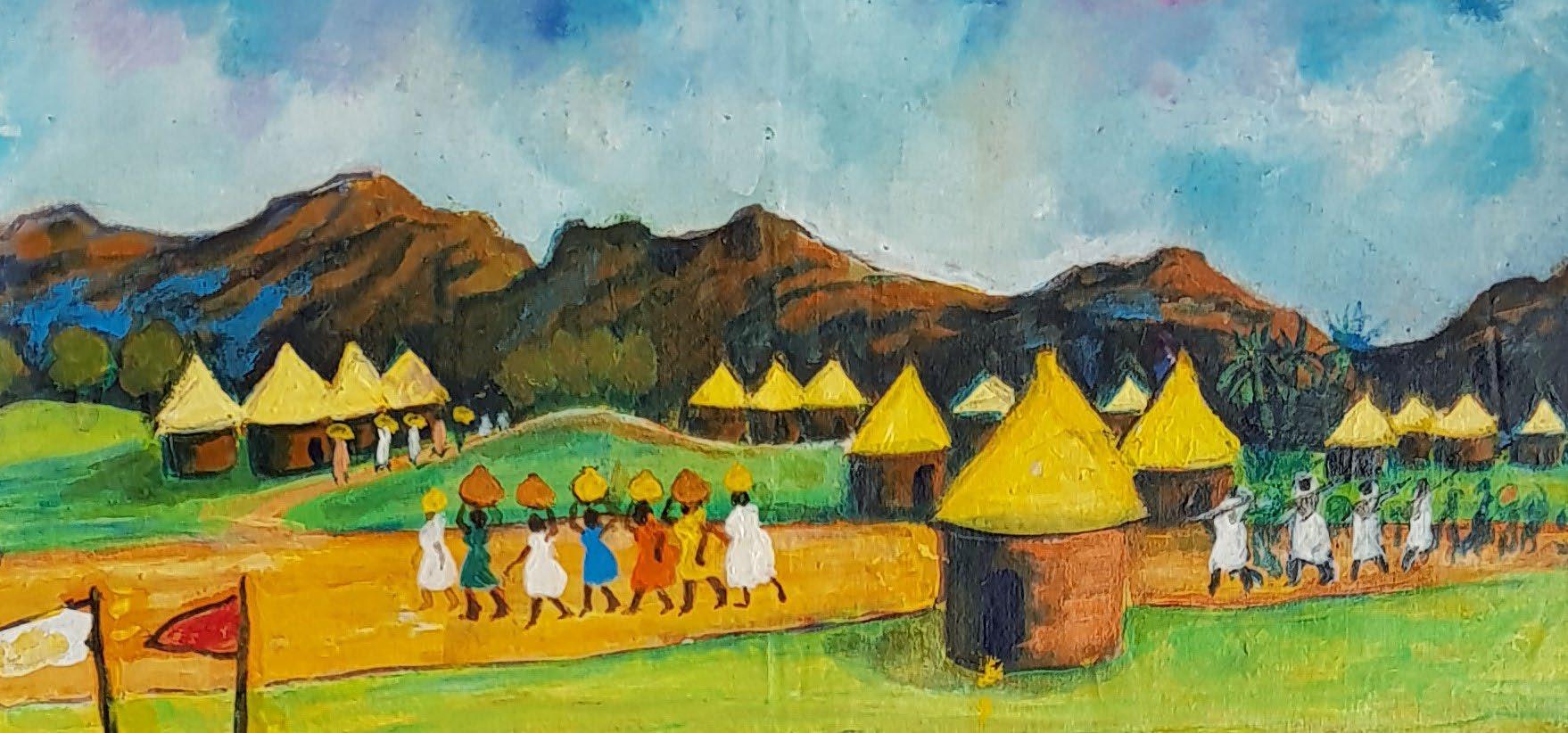

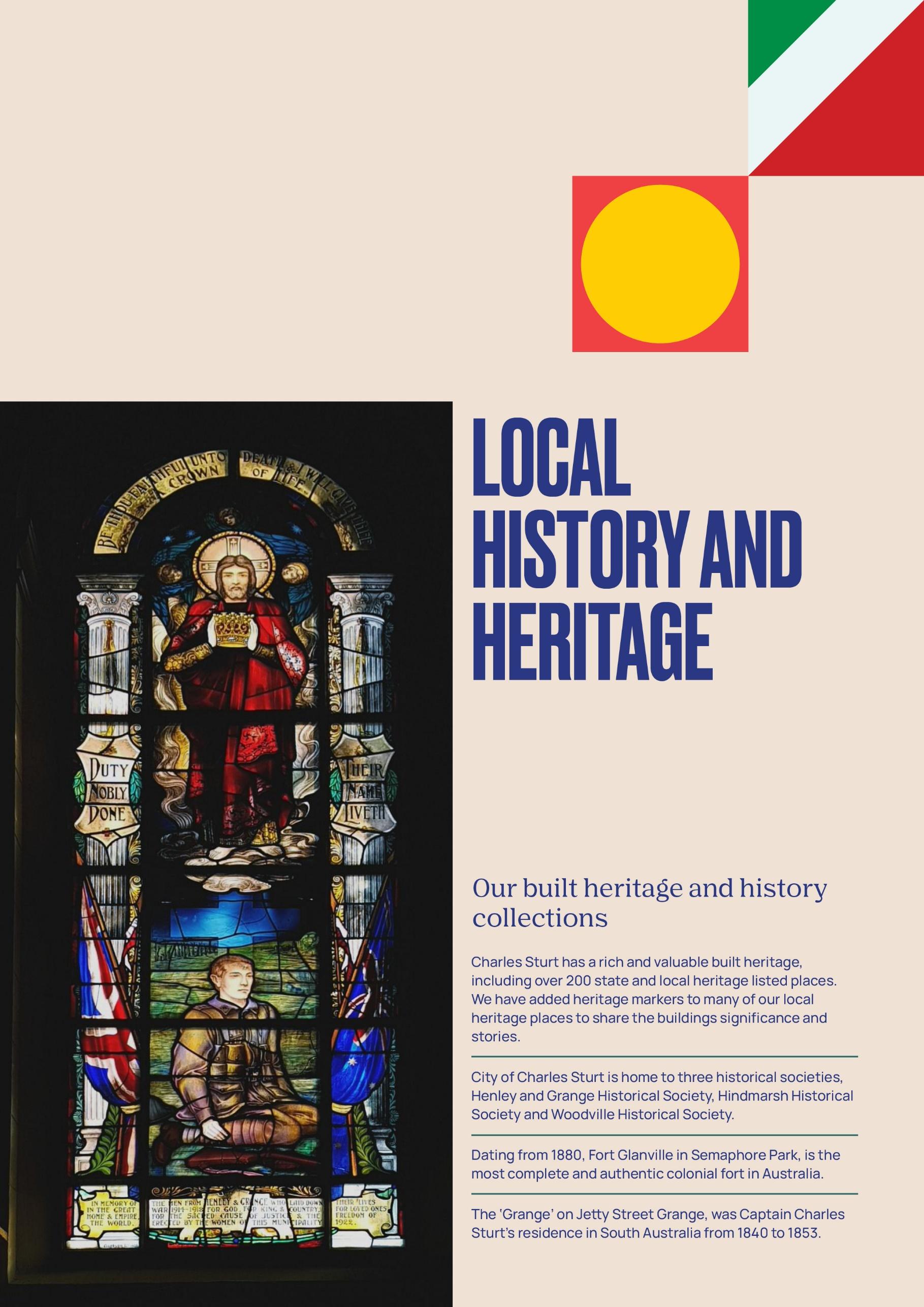
Henley and Grange Historical Society (H&GHS), recording, archiving and sharing the history of Henley and Grange
Surrounded by shelves of archived material and past copies of the societies many journals packed into the History room at the Henley Town Hall, I met with Marie Hagen, one of over 100 members of the Hindmarsh Historical Society and 20 active volunteers.
It began in 1979 and was started by a very active group of volunteers who were concerned at the loss of Henley and Grange’s history, the changes that were happening and the loss of the memories and stories of people that have passed on. Henley and Grange had been a very isolated community in regards to the way it was cut off from the rest of Adelaide because of the flood plains and the swamp lands, so it had developed its own distinct history and character. The society meet five times a year, with guest speakers on topics usually related to the Henley and Grange area but also wider historical topics. We also conduct guided walks explaining the history of the area. We have just developed an App which is a mobile walking tour and are in the process of expanding it to include Henley South and hope to add Grange in the future. We also write a journal every year, we are up to number 42 now. We have had a few publications, one is a chronological history of Henley and Grange and another is a compilation of the best of our journal articles. We have members doing research and answering general enquiries from the public and are in the process of creating a comprehensive database and building up our website.
We would like to put many of our records on the library system so when people go to the local library they can access our information. We can’t do this ourselves, we need the help of a professional librarian. We would like to

use more interactive tools that we could put on our website i.e. pin-points on a local map showing what was once there in juxtaposition of what is there now.
How do collections, like the one at H&GHS, contribute and express our cultural life?
Giving a sense of the spirit of a place, who has been here before and knowing the environmental impacts. We have our ‘old timers’ talk about how there used to be more sand hills and how they have been eroded or removed, how the water was fresher and cleaner, the strong community spirit fostered by a lot of Church groups, organisations and clubs, and more public transport that facilitated people coming together. The type of architecture that we had that was built for beachside living. Knowing about people who came here for their holidays because Henley was built to be a seaside resort.
What is the hope for H&GHS’s future?
We are trying our best to attract new members and to get the stories out there more. For example, how the older buildings are on the higher ground because further east it was swamp lands, and the River Torrens did not flow out the sea, it stopped near Tapleys Hill Road. To understand the geography and topography as well as the heritage of the area. As well as the strong history of arts, performance and literary heritage in the area. The history of the Kaurna people acknowledged.
What actions would you like to see included in an ambitious arts and culture plan for our city?
I would like the different uses of particular areas remembered. A good example would be Henley Square The circular building plaques which give a little bit of history could be used on other historic areas. If a modern structure is built it could reference what was there in its architecture or decoration. Norfolk Island Pines are seen by many as iconic, a symbol of a beachside suburb, so many were planted by local school children, perhaps share the stories about the trees, highlighting their longevity and beauty.
http://henleyandgrangehistory.org.au
Our history and heritage add character and distinctiveness to our neighbourhoods and are fundamental in creating a ‘sense of place’ for our community.
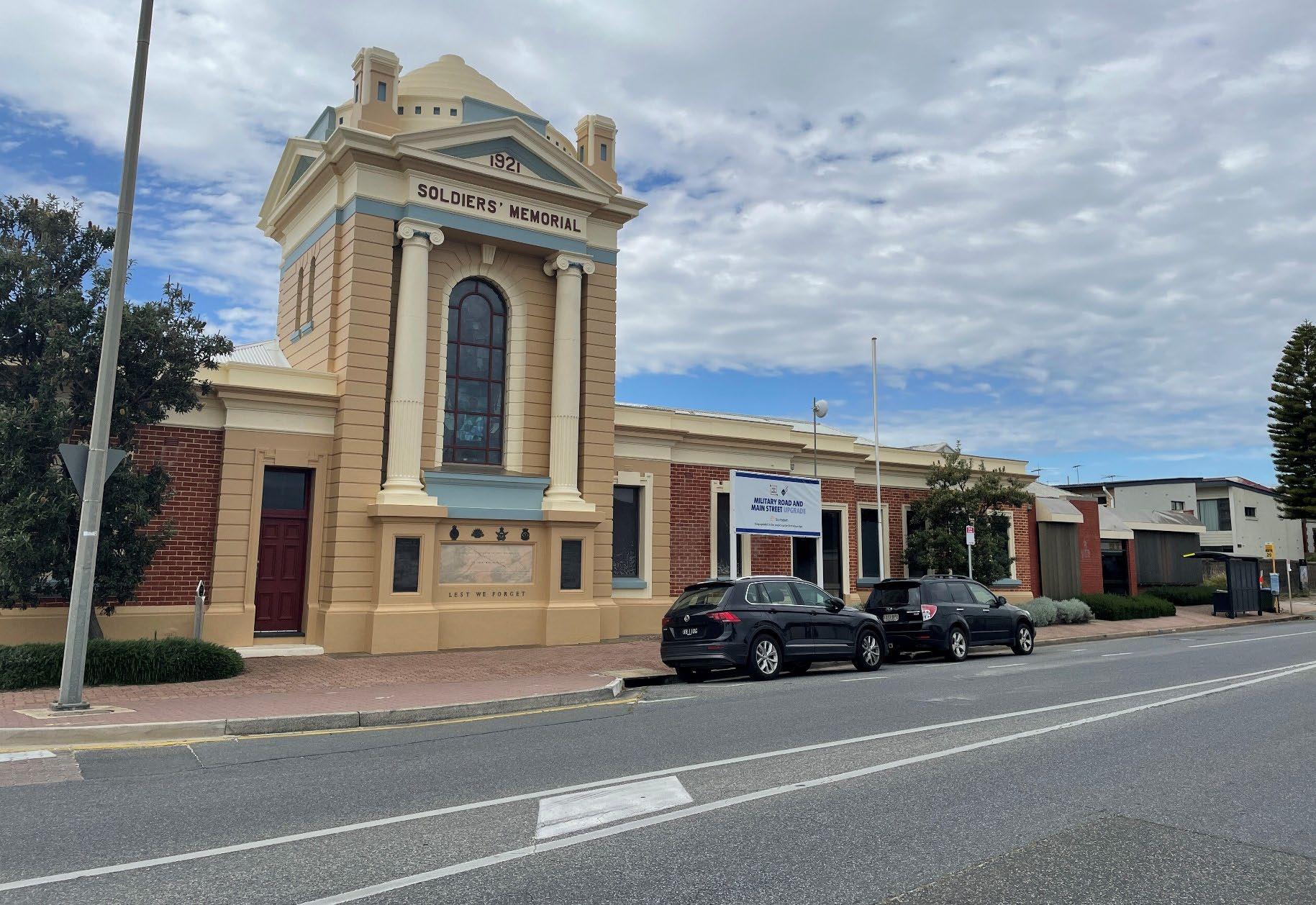

How can Council creatively share the local history and heritage of our city and role could technology play?
How can Council work more collaboratively with Historical Societies and attract more volunteers to support their future?

